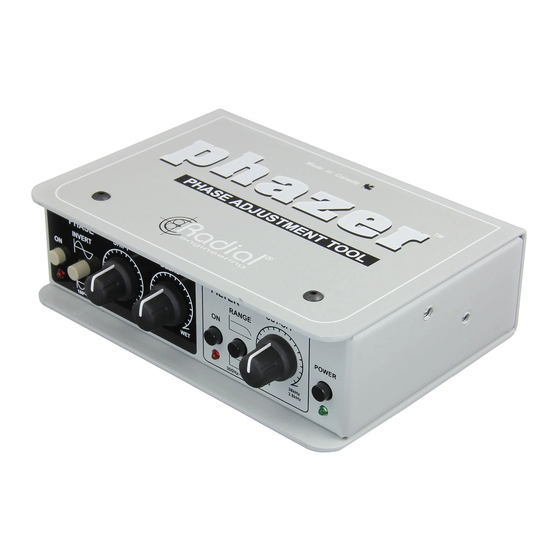Advertisement
Quick Links
®
INTRODUCTION
The Radial Phazer is a phase adjustment tool designed to allow the user
to quickly time-align two sources to create fat rich tones or open the audio
landscape to all kinds of new and exciting sounds. Line level connections
are generally done via the insert point of the console or by taking a direct
feed from a line level device such as a mic preamplifi er. Power comes
from the 15VDC supply that is provided.
The Phazer features two basic control sections: a variable phase shift that
spans from 0º ~180º and a low-pass (high-cut) fi lter. Both control sections
feature an on-off switch that lets you monitor the effect when introduced
into the signal path. Usually, one would start by adjusting phase of the
nearest source (ie close mic versus room mic) by turning the knob until the
two sources 'sound' right. *Note that a polarity reverse switch is used to
toggle the phase from the 0º ~180º to 181º ~ 360º range. This is performed
at the XLR output.
As microphones and/or direct boxes can often be phase reversed, you
should try depressing the polarity reverse (360º) switch to see what range
sounds best. Keep in mind that it is impossible for all frequencies to line
up or be in phase as each frequency has a different wavelength and
the physical distance and/or propagation time will vary. Ultimately, when
using the Phazer you must use your ears to fi nd what sounds best to you.
Because most of the energy is in the low frequency spectrum, you will fi nd
that most of the audible effect will occur in the fi rst half of the control range
between 8 o'clock and 11 o'clock. This is normal. As you move beyond this
point, the potentiometer will mostly affect higher frequencies.
Once you have found the 'sweet spot' try engaging the low-pass fi lter to
hear its effect. This fi lter is designed to roll off high frequencies so that you
can focus the Phazer's effect on the fundamentals or bass frequencies.
When the knob is fully clockwise, the fi lter is essentially out. As you rotate
counter-clockwise, the fi lter cut-off point will begin to take effect. There are
two ranges to choose from.
A fun effect is to combine a direct feed such as coming from a guitar amp
direct box like the Radial JDX with a mic'd feed from the amplifi er. By
purposely setting these out of phase you can recreate tones reminiscent
of Tom Schulz's 1970s Boston that are absolutely stunning! The Phazer
is a fun creative tool for studio and a must have to quicken up live sound
checks. Have fun!
www.radialeng.com
Radial Engineering Ltd. 1638 Kebet Way, Port Coquitlam, BC V3C 5W9
tel • 604-942-1001 fax • 604-942-1010 email • info@radialeng.com
For more information on this and other products please visit our website www.radialeng.com.
Specifi cations and appearance subject to change without notice. Copyright © 2007, all rights reserved.
PHAZER™ - PHASE ADJUSTMENT TOOL
True to the Music
APPLICATIONS
Phazer and Radial JDX
Phazer and Radial J48 Direct Box
Phazer and Two Microphones
Radial Quick Start Manual
For more information please visit www.radialeng.com
JDX Amp Direct Box
Distant
Microphone
ect
Distant
Microphone
Close Mic
Insert Phazer on
JDX channel.
Microphone
Insert Phazer on
direct box channel.
Insert Phazer on
close mic channel.
Advertisement

Summary of Contents for Radial Engineering PHAZER
- Page 1 Distant Microphone using the Phazer you must use your ears to fi nd what sounds best to you. Because most of the energy is in the low frequency spectrum, you will fi nd that most of the audible effect will occur in the fi rst half of the control range between 8 o’clock and 11 o’clock.
- Page 2 Phazer on. CONNECTING THE PHAZER. There are two ways you can connect the Phazer, via the console insert points or in-line. This is done by connecting a ¼” TRS insert cable to the insert points on the mixing console or by connecting the Phazer in-line using the +4dB XLR connectors from a mic preamp output to the line level input of your console or DAW.
















